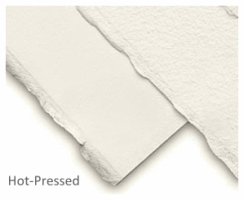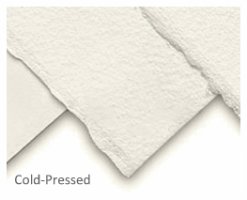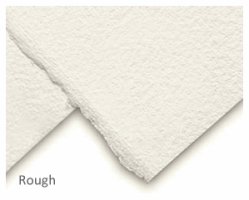


About Paper
There are many different types of paper and each kind give a unique feel. The 100% cotton quality has an ideal absorbency and a superior strength. Naturally white, acid free and made entirely without bleaching agents, for an optimal conservation over time.
Here is more information about weight and grain. It may help you chose the paper best suited for your particular medium.
PAPIR IS NOT JUST PAPER!
Production of Paper & What do they mean with acid or acid-free?
Paper in our time is either made from wood-based pulp or cotton. Acid-free generally means paper that if infused in water yields a neutral or basic pH (7 or slightly greater). It can be made from any cellulose fiber as long as the active acid pulp is eliminated during processing. It is also lignin- and sulfur-free. Cotton is acid-free and it's paper products are the best to use when it comes to most artistic projects, as well as framing and restoration.
Regular paper that has not had its lignin removed turns yellow, becomes brittle, and deteriorates over time. When exposed to light and/or heat, the molecules in the acidic paper will break down even faster as it oxidizes the paper. Acidic wood-pulp paper became commonplace in the late 19th century, and in the 1930's William Barrow (a chemist and librarian) published a report about the deterioration of acidic paper in the libraries. For fear of the gradual disintegration of written materials, measures have since been taken to improve the quality of paper.
What kind of Drawing paper should I chose?
Why is it important to use drawing paper instead if just regular paper from my printer?
Besides the fact that regular printer paper is not acid-free, it is not ideal for several other reasons. Printer paper tends to be too smooth to really work with many mediums. You need some tooth to the paper to really get the best results. As soon as you use anything softer than a 2H pencil, it will easily smudge and the image itself may also just disappear since it hasn't the grain/tooth to keep it on the page. It depends on what you will be drawing with, but in general, paper with a bit of grain/tooth is also better for conté, charcoal and softer pencils, though it is generally a good idea to use a fixative spray when finished.
Another good reason to use a heavier weight of paper designed for drawing is durability. Thin papered sketchbooks are fine for croquis/nude model drawing but as soon as you use an eraser or are too rough, the paper may tear. Work where any revisions are made, will be easier on heavier paper. Paper with 200 to 300 gr. allows for repeated erasing and redrawing of lines. It is great for pen and ink drawings and also when adding multiple mediums, including light watercolour washes, without destroying the paper. Ordinary paper simply cannot hold up to these artistic methods.
Watercolour paper
Watercolour Paper is made using a mixture of water and cellulose fibers. The fibers should be 100% cotton which makes it strong but pliable. Paper products made from cotton is often referred to as "rag paper" or ''archival'. Watercolour paper is usually made by one of three processes: handmade, mold-made or machine-made. Handmade is the best and mold-made comes in a close second. Both are very durable, stable and shouldn't distort under heavy wash. They both feature irregular surface textures which are pleasing to paint on. If you buy artists' quality paper it should be either handmade or mold-made. Less expensive watercolour paper can be made using wood pulp, or sometimes a combination of cotton and other cellulose fibers, where the acids have been removed and it's been



Weight
Since the best quality papers can come in all weights, the weight of the paper is not necessarily a sign of good quality. But weight is important to consider, since some mediums and methods are better for certain weights. It can be lovely to draw on a fine grained 220 gr. paper for example, but with drawing the grain is often more of a factor than the weight. With pen and ink drawing, the weight is important since a lighter grade paper wouldn't stand very much scratching with a nib, but is perfect for fine drawing, where a heavier paper can withstand all the scratching your nib may give it.
Heavy paper is important if you are going to be wetting the paper. In the case of watercolour, a lighter paper would need stretching before use, since the paper may buckle or wrinkle when wet. The weight of the paper plays an important factor when working with printmaking and watercolour.
Heavy papers can take a lot more abuse, are more versatile, and, yes, also more expensive. Most play around on a lighter paper and more 'serious' on a heavier paper. I always try and tell myself when I use the heavier paper that it is thick enough that I can always just paint over it with acrylic if it doesn't go my way just then, which is easily done on a heavy grade paper. They are available in all kinds of textures, grains and sizes. Light paper is anything less than 140 lb / 300 gsm and heavy is 300-400 lb / 600-850 gsm.
Texture
When it comes to texture and grain and which kind to use for which purpose, it has a lot of it is experience and personal taste.
Hot-pressed paper has a smooth, hard surface. Some artists like hot-pressed paper for detailed work, especially for pen and ink drawing, but others find it too slippery. It is not especially good for pencil or charcoal since there is little for it to hold on to and smudges easily away.
Cold-pressed paper (sometimes referred to as "Not paper," such called, because it is not hot-pressed) is the most versatile paper texture, suitable for beginners and experienced painters alike, because it's semi-rough surface is suitable for both detailed work and smooth washes. It is available in three texture grades: FINE, MEDIUM FINE and ROUGH. Each sheet has a 'smoother' side and a 'rougher' side.



